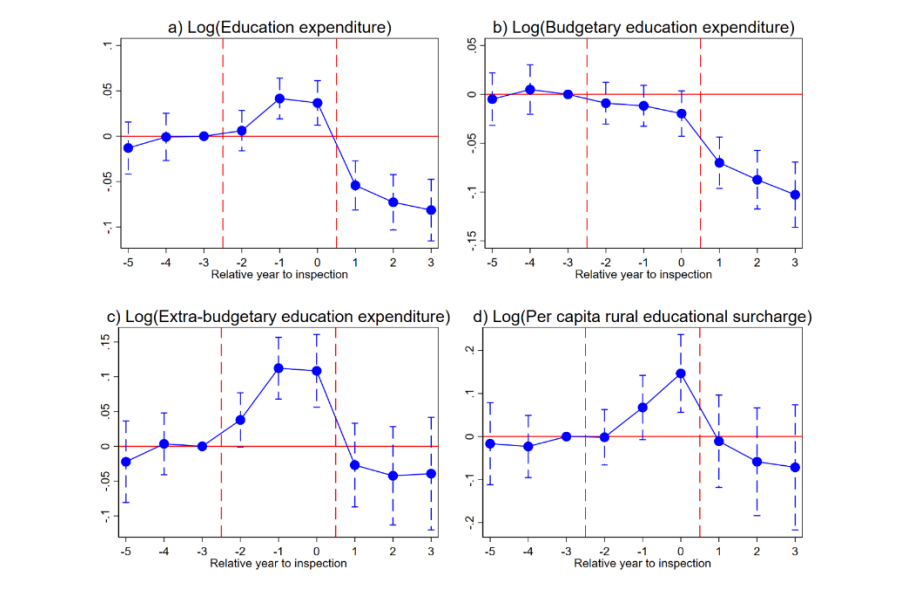Window Dressing in the Public Sector: Evidence from China’s Compulsory Education Promotion Program
We document public-sector window dressing behavior in China’s Compulsory Education Promotion Program during the 1990s. Each county was given a specific year by which it must meet performance targets including the educational expenditures and enrollment rates for primary schools and junior high schools, in order to be designated as a certified compulsory education county (CCEC). We show that as the pre-specified CCEC inspection period approached, county-level education expenditures (especially those funded by extra-budgetary expenditures) shot up; however, soon after the inspection concluded, these expenditures dramatically decreased.

Window-dressing behavior has been well-documented in various organizations when an agent faces high-stakes incentives. In the corporate world, accountants may use creative methods to improve the appearance of financial statements, such as delaying supplier payments to create a higher period-end cash balance (e.g., Lakonishok et al. 1991, Agarwal et al. 2014). In the public sector, bureaucrats may strategically pursue policy actions to appease voters or upper-level government officials. While window dressing behavior can be generally classified as distortions generated by high-powered incentives (Finan et al. 2017), it is conceptually different from other distortions, such as data manipulations (Fisman and Wang 2017) or multitasking agency problems (Holmstrom and Milgrom 1991). Window dressing frequently induces resource allocation across expenditure categories and over time to cater to the principal ex ante; once the incentives to window dress are absent, the resource allocation will revert.
In our recent study (Fang, Liu, and Zhou 2023), we delve deep into this behavior within China’s Compulsory Education Promotion Program during the 1990s. In 1992, the Chinese central government set forth an ambitious initiative whose goal was to ensure nine years of compulsory education for all school-age children and generally eradicate illiteracy among young and middle-aged adults by the year 2000. To achieve this, they created targets for each province, and these provinces subsequently set targets for their respective counties. The success of these counties in achieving their education targets would be certified through inspections at predetermined timelines. The Ministry of Education established specific performance targets that would be examined during the inspection, including the educational expenditures and enrollment rates of primary schools and junior high schools. If a county met its targets, it would be recognized as a certified compulsory education county (CCEC). However, once the inspection team awarded a county the CCEC, there would be no more inspections by upper-level governments, and there was no extra reward for overfulfillment of the target.
For many counties, these targets were quite ambitious, so to meet them would be financially daunting. Local leaders who were responsible for resource allocation faced a dilemma. While there was a national push toward educational improvement, their personal career advancement was often more closely tied to the economic growth of their region than to educational outcomes. Given such career incentives, many might be less inclined to prioritize education unless under scrutiny.

Figure 1: Effects of the CCEC Inspections on Educational Inputs
Figure 1 shows an interesting pattern that illuminates how local governments engaged in strategic resource allocations. The horizontal axis represents the years relative to the year of pre-scheduled CCEC inspection (which is defined as year 0). As the pre-specified CCEC inspection period approached, county-level education expenditures (especially those funded by extra-budgetary expenditures) shot up. This gave the impression of increased commitment to the education goals. However, soon after the inspection concluded, these expenditures dramatically decreased. We interpret this phenomenon as evidence of local governments’ window-dressing behavior, which consisted of mobilizing/reallocating resources to temporarily “meet” the targets before the deadline and then reversing the course after passing the inspection. This behavior is a classic example of window-dressing, where resources are temporarily pumped into a sector for the purpose of passing the inspection, and then pulled back once the evaluation was over.
We further document that such window-dressing practices were particularly pronounced among county party secretaries closer to their promotion evaluations, revealing a clear link between political incentives and window-dressing behaviors. While such behavior might offer short-term gains for bureaucrats in the form of promotions or accolades, it could have negative long-term implications for the public. We find that teenagers exposed to local governments’ window-dressing behavior experienced lower junior high school graduation rates and poorer labor market outcomes later in their life. In conclusion, while window-dressing might have served the immediate interests of those in power, it came at the cost of the well-being of the intended beneficiaries of the program, as seen in those students affected by the fluctuating educational expenditures.
The analysis of China’s Compulsory Education Promotion Program sheds light on the consequences of such practices in the public sector, which is not peculiar to China and can apply to broader contexts that feature top-down target setting, performance evaluation, and strong political incentives. Moreover, the window-dressing behavior we document may serve as an important contributor to the broader problem of information loss in non-democracies.
Our findings also have clear policy implications. A one-time inspection is insufficient because the essence of window dressing is the intertemporal reallocation of resources across different categories. Thus, a random repetitive inspection strategy is useful for mitigating the incentive for window dressing.
(Hanming Fang, Department of Economics, University of Pennsylvania; Chang Liu, National Academy of Development and Strategy, Renmin University of China; Li-An Zhou, Guanghua School of Management, Peking University)
References
Agarwal, Vikas, Gerald D. Gay, and Leng Ling. 2014. “Window Dressing in Mutual Funds.” Review of Financial Studies 27 (11): 3133–70. https://doi.org/10.1093/rfs/hhu045.
Fang, Hanming, Chang Liu, and Li-An Zhou. 2023. “Window Dressing in the Public Sector: Evidence from China’s Compulsory Education Promotion Program.” Journal of Public Economics, 222, 104878. https://doi.org/10.1016/j.jpubeco.2023.104878.
Finan, Federico, Benjamin A. Olken, and Rohini Pande. 2017. “The Personnel Economics of the Developing State.” Handbook of Economic Field Experiments 2: 467–514. https://doi.org/10.1016/bs.hefe.2016.08.001.
Fisman, Raymond, and Yongxiang Wang. 2017. “The Distortionary Effects of Incentives in Government: Evidence from China’s ‘Death Ceiling’ Program.” American Economic Journal: Applied Economics 9 (2): 202–18. https://doi.org/10.1257/app.20160008.
Holmstrom, Bengt, and Paul Milgrom. 1991. “Multitask Principal-Agent Analyses: Incentive Contracts, Asset Ownership, and Job Design.” Journal of Law, Economics, and Organization 7: 24–52. https://www.jstor.org/stable/764957.
Lakonishok, Josef, Andrei Shleifer, Richard Thaler, and Robert Vishny. 1991. “Window Dressing by Pension Fund Managers.” American Economic Review 81 (2): 227–31. https://www.jstor.org/stable/2006859.

Latest
Most Popular
- VoxChina Covid-19 Forum (Second Edition): China’s Post-Lockdown Economic Recovery VoxChina, Apr 18, 2020
- China’s Great Housing Boom Kaiji Chen, Yi Wen, Oct 11, 2017
- China’s Joint Venture Policy and the International Transfer of Technology Kun Jiang, Wolfgang Keller, Larry D. Qiu, William Ridley, Feb 06, 2019
- The Dark Side of the Chinese Fiscal Stimulus: Evidence from Local Government Debt Yi Huang, Marco Pagano, Ugo Panizza, Jun 28, 2017
- Wealth Redistribution in the Chinese Stock Market: the Role of Bubbles and Crashes Li An, Jiangze Bian, Dong Lou, Donghui Shi, Jul 01, 2020
- What Is Special about China’s Housing Boom? Edward L. Glaeser, Wei Huang, Yueran Ma, Andrei Shleifer, Jun 20, 2017
- Evaluating Risk across Chinese Housing Markets Yongheng Deng, Joseph Gyourko, Jing Wu, Aug 02, 2017
- Privatization and Productivity in China Yuyu Chen, Mitsuru Igami, Masayuki Sawada, Mo Xiao, Jan 31, 2018
- How did China Move Up the Global Value Chains? Hiau Looi Kee, Heiwai Tang, Aug 30, 2017
- China’s Shadow Banking Sector: Wealth Management Products and Issuing Banks Viral V. Acharya, Jun Qian, Zhishu Yang, Aug 09, 2017




 Facebook
Facebook  Twitter
Twitter  Instagram
Instagram WeChat
WeChat  Email
Email 


